SAE / AISI 1518 steel is a high-carbon chromium alloy that has excellent wear resistance and corrosion resistance. It is frequently used in tooling and other applications where abrasion resistance and durability are required. In addition to its superior abrasion resistance, SAE / AISI 1518 steel also has a good heat resistance and machinability. Let’s take a closer look at this versatile alloy.
AISI 1518 Steel Composition
Alloy steel is an alloy of carbon, manganese, sulfur, and phosphorous. With a low carbon content, this alloy offers improved machinability compared to other steel alloys such as 1020 steel. This type of steel is also relatively easy to weld and join for construction projects due to its high strength, low cost, and excellent forming properties. Additionally, this versatile material can be heat treated for different applications. Whether you are looking for intricate structures or thick beams, AISI 1518 is the superior choice for your needs.
| Element | Weight % |
| C | 0.15-0.21 |
| Mn | 1.10-1.40 |
| P | 0.04 (max) |
| S | 0.05 (max) |
AISI 1518 Steel Physical Properties
Grade Steel is an economical, low-alloy steel with a wide range of physical properties. It features good cold and hot workability, has relatively low carbon content for flexibility in welding applications, and has superior weldability. In addition, AISI 1518 Steel is highly resistant to climate changes, making it suitable for construction in many different climates. Moreover, its good formability allows it to be machined into exact shapes to meet specific design criteria. Ultimately, all of these physical properties make AISI 1518 Steel an ideal choice for a wide variety of engineering applications that require consistent physical performance over extended periods of time.
| Quantity | Value | Unit |
|---|---|---|
| Thermal expansion | 16 – 17 | e-6/K |
| Thermal conductivity | 16 – 16 | W/m.K |
| Specific heat | 500 – 500 | J/kg.K |
| Melting temperature | 1370 – 1400 | °C |
| Service temperature | 0 – 500 | °C |
| Density | 8000 – 8000 | kg/m3 |
| Resistivity | 0.7 – 0.7 | Ohm.mm2/m |
AISI 1518 Steel Mechanical Properties
1518 steel is a versatile option when it comes to structural engineering because of its mechanical properties. It provides excellent weldability, formability, and machinability due to its low carbon content and excellent toughness in the normalized condition. Additionally, its low sulfur content helps prevent embrittlement which could reduce its ductility. This combination of features makes AISI 1518 steel a popular choice for use as structural components in many different types of applications. Its easy workability, remarkable strength-to-weight ratio, and extreme resistance to corrosion make AISI 1518 an ideal metal solution for any engineering project.
| Properties | Conditions | ||
|---|---|---|---|
| T (°C) | Treatment | ||
| Density (×1000 kg/m3) | 7.7-8.03 | 25 | |
| Poisson’s Ratio | 0.27-0.30 | 25 | |
| Elastic Modulus (GPa) | 190-210 | 25 | |
| Tensile Strength (Mpa) | 1158 | 25 | oil quenched, fine grained, tempered at 425°C |
| Yield Strength (Mpa) | 1034 | ||
| Elongation (%) | 15 | ||
| Reduction in Area (%) | 53 | ||
| Hardness (HB) | 335 | 25 | oil quenched, fine grained, tempered at 425°C |
Thermal Properties
| Properties | Conditions | ||
|---|---|---|---|
| T (°C) | Treatment | ||
| Thermal Conductivity (W/m-K) | 42.7 | 100 | |
| Specific Heat (J/kg-K) | 477 | 50-100 | |
Uses
Alloy 1518 carbon steel is often used in tooling applications where abrasion resistance is required. It is also used in other applications where durability and wear resistance are needed, such as in gears, shafts, and bearings. This steel alloy can also be used for welding purposes.
Corrosion Resistance
SAE / AISI 1518 steel has excellent corrosion resistance thanks to its high chromium content. This alloy will resist corrosion in both acidic and basic environments. In addition, it is resistant to oxidation at high temperatures.
Heat Resistance
SAE / AISI 1518 steel has good heat resistance, making it ideal for use in applications where high temperatures are a concern. However, this alloy should not be used at temperatures above 1200 degrees Fahrenheit (649 degrees Celsius) as it may lose some of its corrosion resistance at these elevated temperatures.
Machining
SAE / AISI 1518 steel can be machined using any standard method. However, this alloy is tough and abrasive, so it may dull cutting tools more quickly than other steels. When machining this alloy, it is important to use sharp cutting tools and plenty of coolants to prevent excessive tool wear. In addition, a slower-than-normal cutting speed should be used to prevent the work hardening of the material.
Welding
SAE / AISI 1518 steel can be welded using any standard welding process. However, due to its high carbon content, this alloy may be susceptible to cracking during welding if proper precautions are not taken. Preheating the material prior to welding and using a low hydrogen welding process can help prevent cracking during welding. In addition, post-weld heat treatment may also be necessary to relieve stress on the weld joint and prevent cracking.
Conclusion
SAE / AISI 1518 steel is a versatile alloy that has excellent abrasion resistance, corrosion resistance, and heat resistance. It can be machined using standard methods but may require sharp tools and extra coolant due to its tough, abrasive nature. This steel can also be welded using any standard process but may require preheating and post-weld heat treatment to prevent cracking during welding. Thanks for reading!

A passionate metal industry expert and blogger. With over 5 years of experience in the field, Palak brings a wealth of knowledge and insight to her writing. Whether discussing the latest trends in the metal industry or sharing tips, she is dedicated to helping others succeed in the metal industry.




